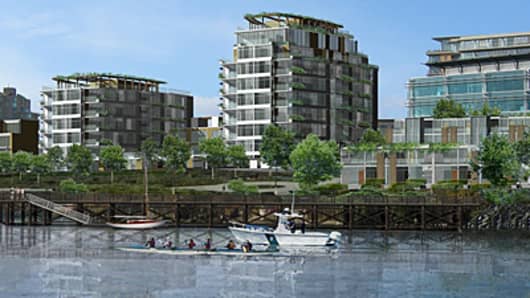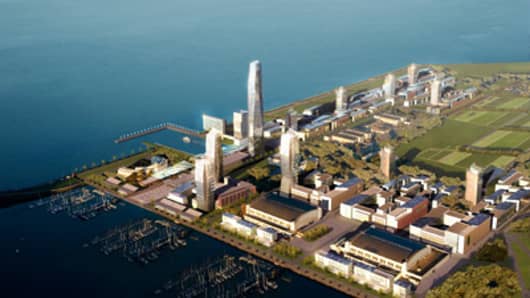The project is one of 16 that was selected by the Clinton Climate Initiative to participate in the Climate Positive Development Program which will set green standards and provide an open flow of information on green technology.
The 16 developments are meant to serve as a model for building sustainable communities.
Besides Destiny, Fla., the only other American project selected is Treasure Island in San Francisco. The rest of the developments are scattered all over the world (Sweden, Brazil, Panama, Canada, Australia, South Africa, the United Kingdom and South Korea.)
The projects are extremely costly and it will take several years—in some cases, decades—before they are completed. Only a couple have actually started construction.
One of them is Dockside Green in Victoria, British Columbia, Canada. Once an abandoned industrial area, developers Vancity Credit Union and Windmill West won over the city with their plan to build a sustainable city and sold the land to them in 2005. Construction began on the 15-acre project in 2006; so far six residential buildings and one commercial one have been built and occupied.
When it is completed, Dockside Green will have 26 buildings and be home to 2,500 people with a percentage of the homes going to lower income people, which is a common theme in all 16 of the communities. The project includes rooftop gardens, a sewage treatment and a pond and stream ecology that treats and filters rain water.
Developer Joe Van Bellegem says joining the Climate Positive Development Program makes it easier to share what he’s learned with other developers. Van Bellegem says he’s already received thousands of requests to tour the site from “developers, mayors, government officials and anyone who is interested in changing policy.”
To limit car use, and the carbon footprint of the community, Dockside Green set up a car sharing program, installed bike racks and made accessing transportation to the city of Victoria easier.
Making the developments more pedestrian friendly, and less dependent on cars, is a major part of all the developments.
Existing cities, like Atlanta and Houston were built to be car oriented, which causes “a lot of environmental problems,” says Maximo Rumis, a principal at DPZ Latin America, which has designed plans for a 120-acre sustainable city in Brazil called Pedra Branca.
Pedra Branca, which is expected to house around 30,000 people when it is completed within the next decade, will be designed so that people can easily walk to stores, libraries and schools, or get around on a bike.
Other developments are finding additional ways to discourage driving. Plans to redevelop Treasure Island, a former Navy Base sitting on a man-made island in San Francisco Bay, includes charging drivers who decide to leave the island during peak hours and offering more accessible public transportation like bus and ferry service.
The redevelopment of the Lower Don Lands in Toronto will extend the city’s already existing light rail system to the site so that when people begin moving in they can use transportation immediately.



